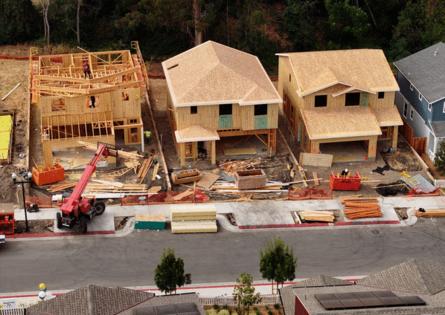The dark side of California's backyard ADU boom: How much do they ease the housing shortage?
Published in News & Features
LOS ANGELES -- With California facing a critical housing shortage, accessory dwelling units now account for a significant portion of the state’s meager growth in new homes, data reviewed by The Times show.
California has struggled to keep up with demand, increasing housing stock by only 0.84% in 2024, or 125,000 units. ADUs made up about one-fifth of those units, according to California Department of Finance data.
ADU construction has been booming in some parts of California, with homeowners taking advantage of the opportunity to build a second housing unit in their backyard. The units often cost hundreds of thousands of dollars, but many residents see them as worthy investments that increase property value.
But ADUs are different from building new apartments and homes. Some ADU owners do not put their units on the market, using them instead for their own families, or leaving them vacant.
And ADUs are more popular in some areas than others.
Eric McGhee, a senior fellow at the Public Policy Institute of California, said it’s hard to know whether new ADUs are being used to house people who wouldn’t otherwise be on the property, or whether they are just providing extra space for those already living there. As a result, it is likely that some ADUs do nothing to ease the housing shortage.
One clue comes from the San Diego Association of Governments, which calculated that 85% of permitted ADUs in the county were renter-occupied units, with only 15% occupied by owners.Advertisement
Still, in many cases, ADUs might be occupied by people spreading out within a property they already occupy, McGhee said, complicating analysis of the impact on the broader housing market.
“Is it enough to just build anything,” he asked, “or do we need to build a certain kind of housing that fills demand better?”
ADU production was up 14.3% in 2024 over the previous year. In 2023, ADU production had grown by 10%. With statewide housing growth relatively steady year over year, ADUs have gained ground and represent a larger portion of new housing.
A Times analysis of finance department data shows that the city of Los Angeles increased its housing stock by 6% between 2020 and 2025, the third-highest figure of Los Angeles County’s 88 cities. Only Duarte and Monrovia added more housing relative to existing stock.
Some cities, such as Avalon, Westlake Village and Cerritos — the bottom three in Los Angeles County — hardly grew at all.
For all of Los Angeles County, housing stock grew by 3.75% over those five years, roughly in line with the statewide figure of 3.87%.
In contrast, some of California’s fastest-growing counties far outpaced sluggish Los Angeles. Madera County grew its housing stock by 2.7% in 2024. Placer and San Benito counties approached 2% annual growth.
And in smaller booming cities, one year of growth was comparable to five years in Los Angeles: In Huron (Fresno County), the housing stock grew by nearly 8% in 2024. Lathrop (San Joaquin County), Winters (Yolo County) and American Canyon (Napa County) all saw growth over 5% that year.
Big cities such as Los Angeles, Oakland and San Diego have been relatively successful in producing new multi-unit complexes, McGhee said, with the vast majority of the new units being one- and two-bedroom rentals.
Where major metropolitan areas have been largely developed and mostly see infill, suburban, peripheral cities such as Huron see “green edge development that is overwhelmingly single-family detached homes,” he said.
L.A. County is a hotbed for ADUs. A 2024 Times analysis showed the county permitted more accessory dwelling units per capita than any other county in the state. The data showed lower- and middle-income cities approving the most construction. Among the cities that permitted the most construction: San Fernando, Rosemead, Temple City, Sierra Madre and Hidden Hills. The cities that built the fewest: Hawthorne, Commerce, Cudahy, Cerritos and Westlake Village.
In a 2024 research project for UCLA’s Lewis Center for Regional Policy Studies, master’s student Miles Austin Cressy studied the western San Fernando Valley — where more than 7% of single-family-residence parcels had been granted ADU permits.
Cressy sought to answer the question that continues to bedevil housing experts: Will ADUs help solve California’s housing crisis?
He found that “ADU prevalence correlates with lower-income, renter-occupied, and younger households, denser populations, and areas with higher concentrations of non-white residents and registered Democrats.”
ADU developments were also less common in hillside and fire-prone areas, suggesting that they might be concentrated in more climate-resilient locations, Cressy wrote.
Finally, the verdict: “ADUs are usually priced at or above market rates and so they have limited viability as a solution to the housing crisis,” the report said. The cheap, abundant housing that Californians crave might not be found in the backyard.
©2025 Los Angeles Times. Visit at latimes.com. Distributed by Tribune Content Agency, LLC.







Comments